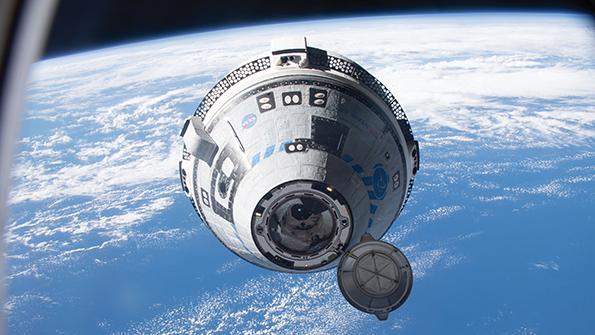
Boeing had hoped to follow the Starliner’s May 2022 Orbital Flight Test-2, during which an uncrewed capsule docked with the International Space Station, with a crewed flight test next month.
Boeing was in the home stretch of preparing its CST-100 Starliner for a pivotal piloted flight test to the International Space Station next month when a routine review uncovered a pair of technical issues that stopped the process cold.
The seeds of Starliner’s latest troubles started long ago. A previously undetected data entry error by Starliner supplier Airborne Systems, which manufactured the spacecraft’s parachute system, obscured the fact that fabric joints on the three main chutes’ suspension lines did not meet the required failure load limits.
- Crewed flight test this year “is possible,” company says
- Boeing’s extra costs for Starliner approach $1 billion
After the error was discovered, the joints, known as soft links, were tested again. “Sure enough, they did fail at the lower limit, and that ended up decreasing our factor of safety in the soft link pretty significantly,” Boeing Vice President and Starliner Program Manager Mark Nappi told reporters during a joint press conference with NASA on June 1. “These data entries were made incorrectly,” he added. “We all take responsibility for that error.”
While engineers brainstormed potential mitigations that could allow the flight to proceed, a second showstopper emerged: the realization that a tape used as a protective wrap over wire harnesses throughout the vehicle has a flammable adhesive.
“Through the flight certification process . . . we were looking at the [fire extinguisher] system in more detail for flammable materials, and that’s when we found the P-213 tape was flammable,” said NASA Commercial Crew Program Manager Steve Stich. “There is some ambiguity in the specifications on the use of that tape. Regardless, we have used it quite extensively in Starliner.” The glass cloth tape protects the wire harnesses from scuffs and chafing, which could cause an electrical short.
“Normally, the tape is on the wiring, and there is no concern for the wiring carrying the current,” Stich said. “It would have to have an exposed conductor in the wire that then shorts to some area. That in turn could cause an ignition event if the circuit protection didn’t trip off the wiring.”
Nappi estimates the amount of P-213 tape in Starliner to be “hundreds of feet.”
“Some wiring, even if it had a little nick, just doesn’t have enough energy to cause combustion of the tape,” Stich added. “It’s only some of the wires that have enough power running through them that could potentially cause combustion.”
NASA and Boeing worked for a week to understand both issues, run tests, review analysis and assess the risks. Ultimately, Boeing CEO David Calhoun and top managers unanimously decided to stand down from flight preparations and fix the problems.
“Safety is always a top priority,” Nappi said. “With human spaceflight, it’s always been that way, so that drives this decision. We’re disappointed because it means a delay, but the team is proud that we’re making the right choices.”
Nappi said it is possible the problems could be resolved in time for the long-awaited Crew Flight Test (CFT) to launch this year.
Boeing told NASA it was delaying the CFT on June 1—about two weeks before the Starliner was to be fueled for a July 21 launch attempt onboard a United Launch Alliance Atlas V. “We know that there are growing pains in developing a vehicle and flying a vehicle,” Nappi said. “We’re really close. This is just part of the business to have these kinds of issues.”
Boeing has learned that lesson repeatedly with the Starliner, one of two commercial space taxis developed in partnership with NASA to fly crews to the International Space Station (ISS) following the retirement of the space shuttle fleet. In 2014, Boeing and SpaceX won contracts worth a combined $6.8 billion for development, two flight tests and six crew-rotation missions of the Starliner and Crew Dragon, respectively.
SpaceX completed an uncrewed flight test in March 2019 and a piloted flight test in May-August 2020. It is preparing for the launch of its seventh ISS crew-rotation mission this summer under contract extensions worth about $2.2 billion for an additional eight flights.
Privately owned SpaceX, based in Hawthorne, California, also completed three private Crew Dragon charters, and a fourth is targeted for launch in November. A key tenet of NASA’s Commercial Crew Program is that the U.S. space agency becomes just one of many customers for rides to low Earth orbit.
Boeing kept pace with SpaceX until the Starliner’s uncrewed flight test in December 2019 exposed software and communications glitches that prevented the spacecraft from reaching the station.
Twenty months later, Boeing was days away from a reflight when it discovered a problem with stuck oxidizer isolation valves on the Starliner service module propulsion system. Later analysis showed that nitrogen tetroxide propellant had leaked through the valve, reacted with moisture and created nitric oxide, which caused corrosion.
Under the terms of its firm, fixed-price Commercial Crew Transportation Capabilities contract with NASA, Boeing bears the costs for repairs and modifications, which had added $883 million to its bill as of October 2022. The latest problems are “too new to determine if [they] will require additional expenses or not,” Nappi said.
“We are finding things now, and that’s a testament to the process,” he added. “It's questionable if we should be catching these types of things this late. That might be because there was a certain sense of optimism when some of the designs were done, and some of the processes were created many years ago. And that led to some of these things . . . creeping their way through the system and having us catch them as late as we are.”
NASA and Boeing remain committed to adding the Starliner to the fleet of vehicles visiting the ISS, which is expected to remain operational until at least 2030.
“NASA desperately needs a second provider for crew transportation,” Stich said. “We are very excited [about] having Boeing get certified and flying our crews to the station.”






Comments